![[Previous]](prev.gif) |
![[Contents]](contents.gif) |
![[Index]](keyword_index.gif) |
![[Next]](next.gif) |
![[Previous]](prev.gif) |
![[Contents]](contents.gif) |
![[Index]](keyword_index.gif) |
![[Next]](next.gif) |
 |
This version of this document is no longer maintained. For the latest documentation, see http://www.qnx.com/developers/docs. |
You can select a topic from this diagram:
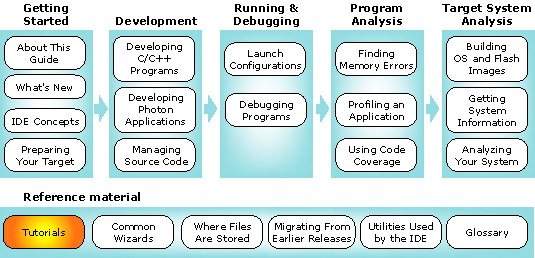
Here are several tutorials to help you get going with the IDE.
In this chapter:
Before you begin the tutorials, we recommend that you first familiarize yourself with the IDE's components and interface by reading the IDE Concepts chapter.
You might also want to look at the core Eclipse basic tutorial on using the workbench in the Workbench User Guide (, then ).
In this tutorial, you'll create a simple, Standard Make C/C++ project (i.e. a project that doesn't involve the QNX recursive Makefile structure).
You use the New Project wizard whenever you create a new project in the IDE. Follow these steps to create a simple "hello world" project:
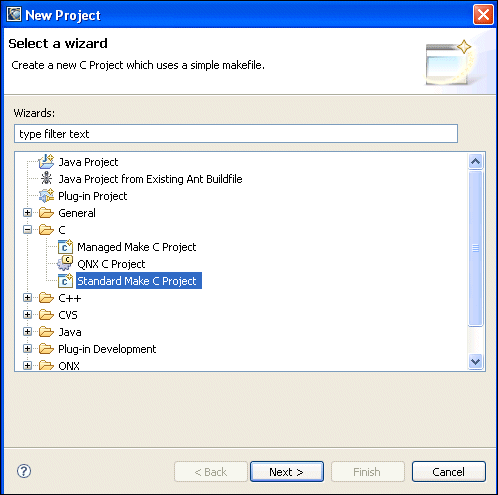
![]()
Here's a sample Makefile you can use:
CC:=qcc
all: hello
hello: hello.c
clean:
rm -f hello.o hello
 |
Use Tab characters to indent commands inside of Makefile rules, not spaces. |
#include <stdlib.h>
#include <stdio.h>
int main(int argc, char *argv[]) {
printf("Hello, world!\n");
return EXIT_SUCCESS;
}
Congratulations! You've just created your first Standard Make C/C++ project in the IDE.
For instructions on building your program, see the section "Building projects" in the Developing C/C++ Programs chapter.
 |
In order to run your program, you must first set up a
Neutrino target system. For details, see:
|
Unlike Standard Make C/C++ projects, a QNX C/C++ project relies on the QNX recursive Makefile system to support multiple CPU targets. (For more on the QNX recursive Makefile system, see the Conventions for Makefiles and Directories chapter in the Neutrino Programmer's Guide.)
Follow these steps to create a simple QNX C (or C++) "hello world" project:
![]()
The New Project wizard appears.
Congratulations! You've just created your first QNX project.
For instructions on building your program, see the section "Building projects" in the Developing C/C++ Programs chapter.
 |
In order to run your program, you must first set up a
Neutrino target system. For details, see:
|
In this tutorial, you'll use the IDE's Import wizard, which lets you import existing projects, files, and even files from ZIP archives into your workspace.
 |
You can use various methods to import source into the IDE. For details, see the Managing Source Code chapter. |
Follow these steps to bring one of your existing C or C++ projects into the IDE:
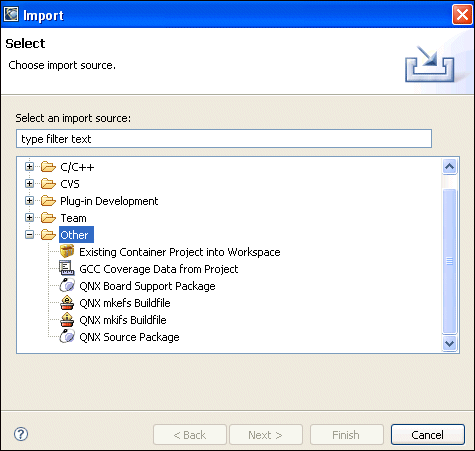
The IDE displays the Import Project From Filesystem panel.
Congratulations! You've just imported one of your existing projects into the IDE.
QNX BSPs and other source packages are distributed as .zip archives. The IDE lets you import both kinds of packages into the IDE:
| When you import: | The IDE creates a: |
|---|---|
| QNX BSP source package | System Builder project |
| QNX C/C++ source package | C or C++ application or library project |
For more information on System Builder projects, see the Building OS and Flash Images chapter.
You import a QNX source archive using the standard Eclipse import dialog:
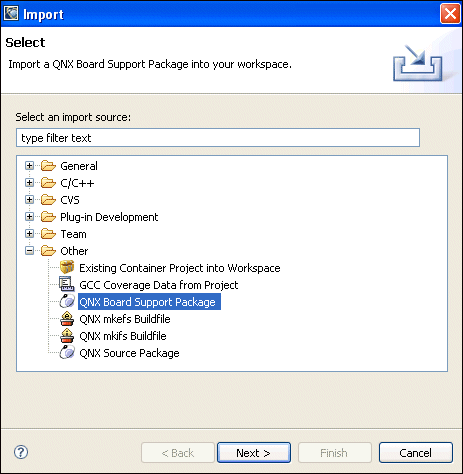
As you can see, you can choose to import either a QNX BSP or a "source package." Although a BSP is, in fact, a package that contains source code, the two types are structured differently and generate different types of projects. If you try to import a BSP archive as a QNX Source Package, the IDE won't create a System Builder project.
After you choose the type of package you're importing, the wizard then presents you with a list of the packages found in $QNX_TARGET/usr/src/archives on your host:
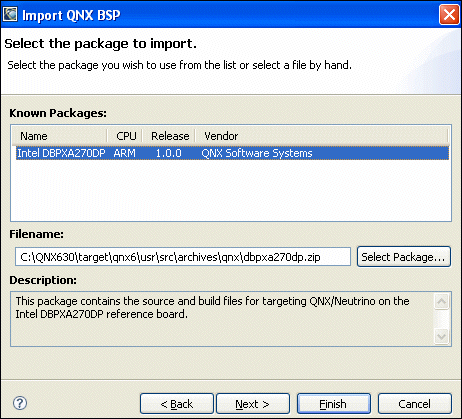
Notice that as you highlight a package in the list, a description for that package is displayed.
To add more packages to the list:
Each source package contains several components (or projects, to use the IDE term). For the package you selected, the wizard then gives you a list of each source project contained in the archive:
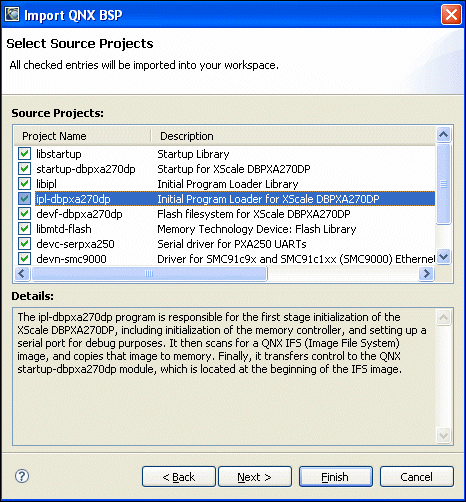
You can decide to import only certain parts of the source package; simply uncheck the entries you don't want (they're all selected by default). Again, as you highlight a component, you'll see its description in the bottom pane.
The last page of the import wizard lets you name your source projects. You can specify:
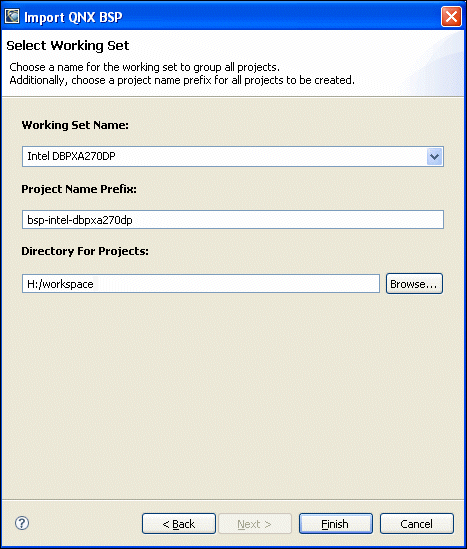
 |
If you plan to import a source BSP and a binary BSP into the IDE, remember to give each project a different name. |
When you finish with the wizard, it creates all the projects and brings in the source from the archive. It then asks if you want to build all the projects you've just imported.
 |
If you answer Yes, the IDE begins the build process, which may take several minutes (depending on how much source you've imported). |
If you decide not to build now, you can always do a Rebuild All from the main toolbar's Project menu at a later time.
If you didn't import all the components from a BSP package, you can bring in the rest of them by selecting the System Builder project and opening the import wizard (right-click the project, then select Import...). The IDE detects your selection and then extends the existing BSP (rather than making a new one).
When you import a QNX Board Support Package, the IDE opens the QNX BSP perspective. This perspective combines the minimum elements from both the C/C++ Development perspective and the QNX System Builder perspective:
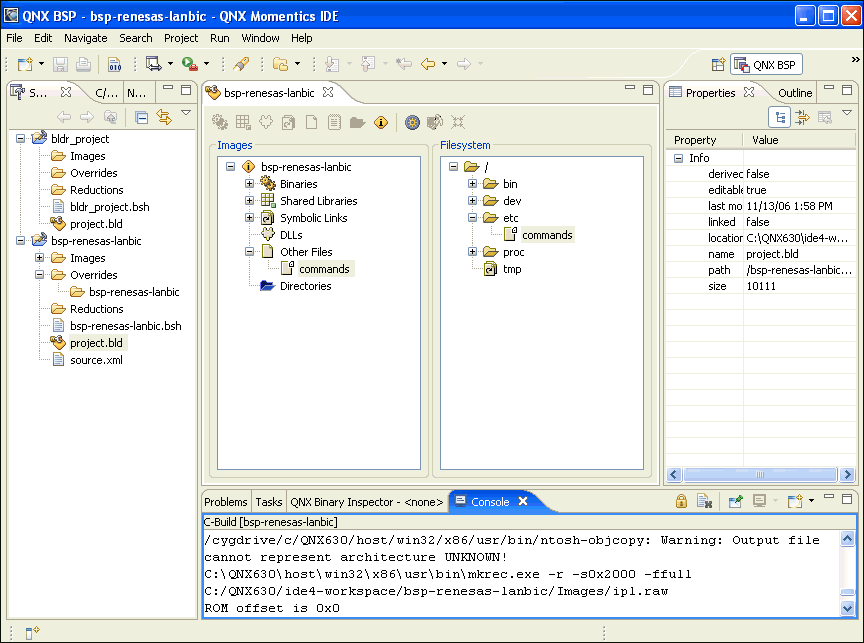
Congratulations! You've just imported a QNX BSP into the IDE.
![[Previous]](prev.gif) |
![[Contents]](contents.gif) |
![[Index]](keyword_index.gif) |
![[Next]](next.gif) |